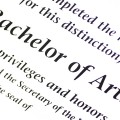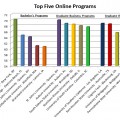In a nutshell: Liberal arts courses develop essential skills that can help businesspeople analyze information, identify trends, communicate effectively and encourage imagination.
What’s the secret to Apple’s success? Steve Jobs, the visionary CEO that founded and then rescued the company, said the answer is not just engineering, design, manufacturing and marketing prowess. It’s also an embrace of the liberal arts.
“Technology alone is not enough,” he said when he introduced the iPad in April 2010. “It’s technology married with the liberal arts, married with the humanities, that yields the results that makes our hearts sing.”
The liberal arts are an ideal complement to a business education. They help students learn how to synthesize information, connect dots, analyze facts, think logically and make educated decisions — real-world skills that contribute to business success.
Drew Gilpin Faust, president of Harvard University, has this to say about the liberal arts: “The opportunities and move in new — and sometimes unexpected — directions will benefit you no matter your interests or aspirations. A liberal arts education is designed to equip students for just such flexibility and imagination.”
What Are the Liberal Arts?
The liberal arts cover a wide swath of academic areas, including:
- Social sciences
- Natural sciences
- Art and music appreciation
- Philosophy
- Math
- Religion
- Economics
- Foreign languages
What these areas have in common is that they aren’t focused on technical or professional skills, such as engineering or accounting. Liberal arts courses are taught at many levels — some classes might be broad introductions to a subject, while others might be narrowly focused on a very particular topic, such as one historical era or a single style of painting.
Liberal Arts and Business
Liberal arts courses help students learn how to ask good questions, process information from many different sources and summarize ideas succinctly. Ideas will resonate across courses: Something taught in a psychology class may apply to art history or philosophy, for example. The objective of an liberal arts education is to help students develop a more well-rounded worldview.
Why should business students pay attention? The Atlantic says liberal arts skills are essential to help businesspeople advance in their careers:
“Put simply, business majors seem to be graduating with some of the technical skills they’ll need to secure jobs, but without having made the gains in writing or critical-thinking skills they’ll require to succeed over the course of their careers, or to adapt as their technical skills become outdated and the nature of the opportunities they have shifts over time.”
Integrating the Liberal Arts into your Business Education
There are many ways to work the liberal arts into your business education. If you’re still planning your educational path, you might want to consider pursuing a liberal arts undergraduate degree first and return to school for a graduate program in business (such as an MBA or master’s in finance). If you’d prefer to focus on an undergraduate business degree, consider a few liberal studies electives to round out your education.
Businessman and investor Mark Cuban sees a bright future for liberal studies students, especially as businesses contend with increasing amounts of information. “… When the data is spit out at you, options are being spit out for you, [and] you need to have a different perspective in order to have a different view of the data,” he said.






